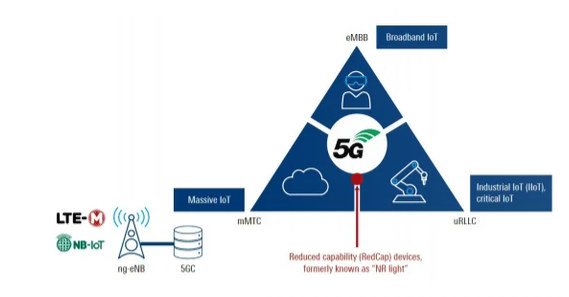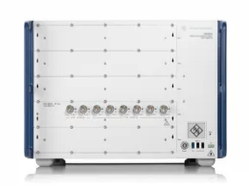New standards promise opportunities for 5G IoT
With the introduction of 5G, 3GPP increased the number of wireless communications use cases. The result is the well-known triangle of services: enhanced mobile broadband (eMBB), ultra-reliable low latency communications (uRLLC) and massive machine type communications (mMTC). The mMTC element covers the service continuation of legacy technologies such as NB-IoT, as well as support for both enhanced and new machine-type services.
This article originally appeared in the Feb'24 magazine issue of Electronic Specifier Design – see ES's Magazine Archives for more featured publications.
By Reiner Stuhlfauth, Technology Manager, Wireless, Rohde & Schwarz.
5G Reduced Capability (RedCap) seeks to meet the internet of things (IoT) need for smaller, simpler and lower cost RF devices with a better battery life than existing 5G products. It targets IoT services that require higher data rates than mMTC services but lower data rates than 5G eMBB. As well as reducing the form factor of IoT devices such as wearables, RedCap technology will be fully integrated into overall 5G systems and represents the first IoT technology based entirely on 5G.
RedCap – user equipment and network
Key aspects of 5G RedCap address both the user equipment (UE) and the network itself – not only will the UE capabilities be reduced but also the network behaviour will be changed. RedCap reduces UE complexity with restrictions, for example, 20MHz maximum bandwidth, single antenna operation, half duplex and reduced modulation scheme. Another capability restriction is the support of only one RAT at any given time, so that a 5G network offering RedCap needs to operate in 5G standalone mode.
In addition, signalling procedures, such as bandwidth part coordination, need to be updated, since the reduced bandwidth capability of the UE requires a reaction or adaptation from the network. The network can also signal UE capability-specific cell access restrictions.
Here, the UE must identify itself as a RedCap UE as early as possible during the random-access procedure so that the network can manage it properly.
Protocol testing
RedCap testing, especially in relation to conformance or certification testing, not only affects the UE implementation but also impacts the network, especially with network restriction signalling.
Rohde & Schwarz has already released RedCap test capabilities for its R&S CMX500 mobile radio tester. The test and measurement capabilities of the platform include TX and RX measurements on the RF layer as well as the ability to test signalling scenarios and relevant protocol testing aspects, such as power-saving test scenarios. The tailored R&S CMX500 ‘OBT lite’ hardware configuration addresses lower data rate applications in all production stages from early research and design to type approval conformance testing.
For mobile network testing, a scanner that decodes the SIB information, such as the R&S TSMA6B, allows proper feature-specific restriction signalling to be verified.
RedCap and other machine-type communications
Today, there are many wireless technologies that claim to support machine-type communications and, more generally, IoT. As such, it is important to outline a classification scheme and provide motivation for the role of RedCap in this ecosystem.
Figure 1. IoT classification in 5G
For example, we can divide IoT technologies into cellular and non-cellular IoT technologies. Prominent examples of non-cellular IoT are standards such as Bluetooth, Wi-Fi, IEEE UWB, Thread, or LoRaWAN, as well as standards supported by the Connectivity Standard Alliance (CSA).
3GPP has defined multiple technologies that leverage machine type communications: for example, GPRS, EC-GSM, NB-IoT, or LTE-M. Now with RedCap, IoT is entering the 5G world.
Figure 2. 5G NR test solution R&S CMX500 OBT Lite hardware configuration
Multiple factors drive the need for RedCap – we want to reduce device complexity, lower energy consumption, have higher throughput machine type communications and benefit from the flexibility of the 5G system and QoS driven network architecture. However, a more fundamental goal is to fully integrate IoT into 5G.
Different IoT applications
Early IoT allowed machines to talk to each other in a simple manner with low data rates and relaxed quality of service (QoS) requirements. This introduction of IoT technology was driven by the idea of a sensor-type UE-oriented network.
Later IoT deployments considered further and more sophisticated classifications. One example is the change from a data-centric downlink smartphone UE type to an incident-triggered IoT device that may need more data in the uplink direction (e.g., a CCTV camera).
Massive IoT consists primarily of wide-area use cases – connecting large numbers of low complexity, low-cost devices that have long battery lives, and relatively low throughput.
NB-IoT and Cat-M technologies complement each other. Globally, 124 service providers have deployed or commercially launched NB-IoT networks, 57 have launched Cat-M and 56 have deployed both.
NB-IoT and Cat-M follow a smooth evolution path into 5G networks; they can continue to be deployed in the same bands even with the introduction of 5G. Commercial devices for massive IoT include a wide range of meters, sensors, trackers, and wearables.
Next-generation eNB (NG-eNB), an updated LTE base station category, connects directly to the 5G core and ensures the longevity of legacy IoT technologies.
Throughput data rates rising
Taking things a step further, broadband IoT extends the technology to wide area use cases that require higher throughput, lower latency, and larger data volumes than massive IoT technologies can support. LTE already supports many use cases in this segment.
By the end of 2025, 34% of cellular IoT connections will be broadband IoT, with 4G connecting the majority. The throughput data rates will increase substantially for this segment with the introduction of 5G New Radio (NR).
Another important application is critical IoT, which is used for time-critical communications in both wide-area and local use cases that require ensured data delivery with specified latency targets. Critical IoT will be introduced in 5G networks with advanced time-critical communication capabilities. The first modules supporting critical IoT use cases were deployed in 2021.
Typical use cases include Cloud-based artificial intelligence and virtual reality, Cloud robotics, autonomous vehicles, and advanced Cloud gaming, as well as real-time coordination and control of machines and processes.









